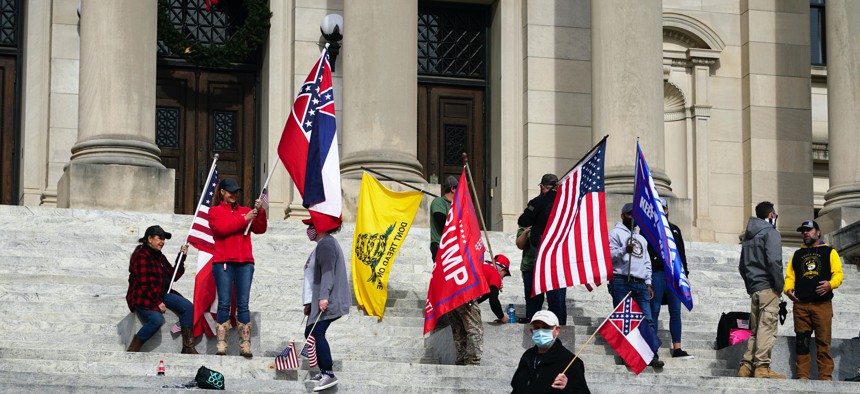
Protestors at the Mississippi state capitol wave the former state flag with its Confederate emblem, the Gadsden flag, and pro-Trump banners on Jan. 6, 2021. AP / Rogelio V. Solis
America’s Far Right Isn’t Authoritarian. It’s Anti-Statist.
The distinction makes a difference in understanding and confronting the threat.
To counter a threat we must first define it. Donald Trump’s inflammatory rhetoric and volatile behavior are distorting our ability to see far-right extremism for what it really is: virulent anti-statism.
To the commentators and pundits who consider Trump an authoritarian, last Wednesday’s attack on the Capitol confirmed him as a dictator-in-waiting and proved that far-right extremism is, at its core, reactionary and authoritarian. But this narrative ascribes to Trump far more influence than he actually wields, and it falls apart upon even a cursory review of the varied goals of far-right groups. Second Amendment groups, for example, want to erect a permanent bulwark against gun control. Christian groups are pushing back against a perceived erosion of religious freedom. And white supremacists want to restrict immigration and minority rights.
In fact, one of the only animating forces that unites the entire far right is a shared fear of centralized state power. Anti-statism—the belief that governments invariably threaten individual liberty—has a long tradition in American strategic culture. Many far-right groups, however, take the concept and run with it. A mythologized view of American history, which treats American exceptionalism as the result of rugged individualism and Darwinian self-reliance, fuels their “radical libertarian” worldview. Events like Ruby Ridge and the Waco standoff “prove” that the state cannot help but infringe on their Constitutionally protected liberties.
Many of these groups also worry that tectonic political and demographic shifts are conspiring to lock them out of the political process. A “replacement theory” frames the reality that whites will soon make up less than 50 percent of the American population as a reason to decry immigration and the decline in white birthrates. These groups also fear the emerging progressive consensus among coastal elites, urbanites, young voters, and minority groups that state power can be a force for good and that the state should play an active role in fostering equal outcomes over marriage, schooling, and policing. Taken together, these trends seem to portend the rise of a permanent and insurmountable political coalition that will support an unstoppable ratcheting of state power.
Tragically, the fact that far-right groups perceive both a closing window of opportunity to act and an existential threat to their way of life means we should expect more violence. Some extremist groups have suggested they are willing to wage civil war to forestall what they see as an unacceptable future.
If far-right extremism is properly understood as an anti-statist movement, Trump’s role in this debacle becomes clearer. He was a political entrepreneur who enabled, empowered, and “normalized” these groups both implicitly (through dog whistles) and explicitly (e.g., “stand back and stand by”). In doing so, Trump built a fervent political following — and invited far-right groups to openly engage in the political process.
It should therefore come as no surprise that the extreme right views Trump’s defeat in apocalyptic terms. His loss of political power means their loss of political voice. But note that they are not raging because they want to install Trump as a dictator. Rather, they see his presidency as a means of dismantling the state as we know it. Should Trump have attempted to expand executive power in a second term — or beyond — many in the far-right would likely turn on him.
All of which suggests that Trump does not—and cannot—control the Frankenstein movement into which he helped breathe life.
Effectively countering the threat demands recognizing it for what it is: a uniquely American strand of virulent anti-statism, not a quest to install Trump as dictator. What comes next is unfortunately not as simple. There are no “quick fixes” for dealing with a challenge such as this. America’s now animated and semi-organized far right is unlikely to go away after Trump leaves the White House. Their deeply ingrained senses of lost power and political and social grievances will endure. And their proclivity toward violence will likely increase now that they believe their voice in the legitimate political process has been “stolen.”
Defusing virulent anti-statism will require a prolonged struggle for hearts and minds. At a minimum, it will demand the sort of sustained attention, resources, introspection, community-building, and legislative action, that the U.S. policy community has never excelled at producing. It will almost certainly mean rethinking the way we produce and consume media, revising our laws surrounding hate speech, and reviewing the actions and policies of the police and military. And, distasteful though it might seem right now, it will also mean finding a way to ensure that those who harbor anti-statist sentiments but reject violence still have a voice in the legitimate political process, subject to public scrutiny.
Christine German is a PhD student in political science specializing in ideological extremism at the Schar School of Policy and Government at George Mason University.
Michael A. Hunzeker is an assistant professor at George Mason University’s Schar School of Policy and Government.



